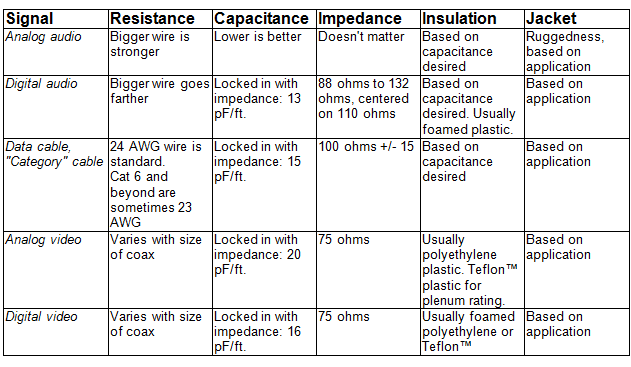Cable Substitution
One of my favorite jokes is about Belden 1800F. This cable is our top-of-the-line for microphone cable. The reason is simple. With analog cable, the key parameter is capacitance. The lower, the better. And Belden 1800F is 13 picofarads per foot (pF/ft.). That's even lower than Category 5e or 6 or 6a (15 pF/ft.).
However, Belden 1800F is also 110 ohms impedance for use with digital audio. In fact, this cable started life as digital audio patch cable. It was a high quality cable that is very flexible, and came in many pretty colors. It says right on the cable, "digital audio". If your customer says, "I can't use this on my analog mics because it says 'digital audio’," there's no problem. I will personally send you a bottle of rubbing alcohol. With that you can rub off the word "digital" and the cable works PERFECTLY after that.
It's not what it says on the cable, it's what is required to run that signal. The table below shows various parameters for different kinds of signals.
You will note that analog cable can have any kind of insulation on the two wires, but that selection influences capacitance, and therefore signal quality and distance. If you buy all-PVC cable, the capacitance will be high and the effective distance will be less than a cable made with a better plastic (polypropylene, polyethylene). What is outside the whole cable (the jacket) is based on cost, and also on where you intend to use this cable. If it's going outdoors, you might want a water-blocking version which can be buried in the ground without a conduit.

And there are many other qualities that might become part of your decision-making process. Flexibility, flex-life (flexes to failure), fire ratings, various kinds of approvals by different industries (shipboard approved cable, for instance). Then there is the all-important question of bandwidth: what range of frequencies is this cable intended to cover? What has it been tested to? And what were the results of this testing? So this list above is just a starting point.
And the idea for this week’s blog came because I am putting together a mini-catalog for the lighting industry. Their standard cable is something called DMX-512. It is based on the RS-485 standard which requires a 120 ohm cable. However, they could also use digital audio cable (110 ohms). That's pretty close. They could even use 100 ohm cable such as Category 5e or 6 or many older versions like "twinax". However, as they move farther away from the correct impedance, more of the signal is reflected back to the source ("return loss"), so choosing a cable with a lower impedance will limit the maximum distance you can go with this signal.
As the bandwidth of the signal goes higher and higher, the wavelength gets shorter and shorter. This means that an alternate cable, especially one with a different impedance, is less likely to be an effective choice. At short wavelengths (quarter wavelength for HD video is slightly over one inch) everything becomes more critical. A cable not designed for this high bandwidth might be a poor choice. Of course, you will find out.
Do you have a story about someone picking the wrong cable, or a cable that worked perfectly when you didn't expect it? Send me the story or just fill out the box below.
